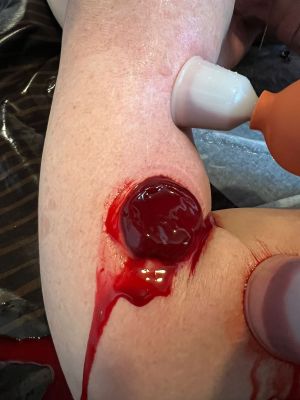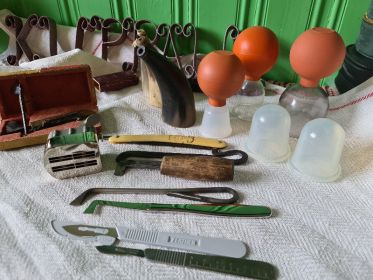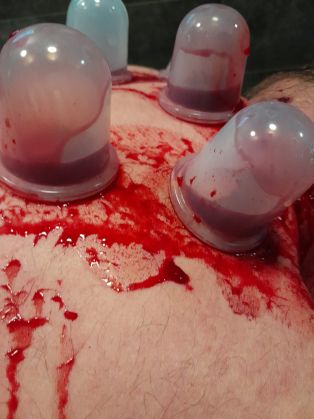Blood cupping
| Blood cupping | ||||
|---|---|---|---|---|
| In the national inventory | ||||
|

Practitioners and people who know the tradition well
There are two types of cupping methods, blood cupping and dry cupping. In dry cupping, no blood is drawn; instead, a cup is placed on the body at a trigger or acupressure point. The cup is left in place for a moment or can be moved around the sore spot or along the direction of lymphatic circulation. The purpose is to relieve pressure causing pain or excess tissue fluid from the area and promote improved blood circulation and oxygen flow to the treated area.
In blood cupping, cups are placed on cleaned skin at trigger or acupressure points, and the skin's surface is allowed to rise for a moment. The body is preheated, possibly in sauna or other relaxing methods, to prepare for treatment and revive surface blood circulation.
Wounds are made using a scalpel, cupping knife, or surgical blade. The cup is then placed back in position. Blood is periodically removed from the cup, and the skin is cleaned of blood. Once the bleeding has stopped, the cups are removed, and the skin is disinfected with a disinfectant skin cleanser.
The effect of cupping is believed to be twofold: as a stimulation treatment at trigger and acupressure points and also by relieving pressure from tissues through the application of negative pressure, which draws blood away from the cupping cup area.
References to cupping date back to the 16th century, and most cuppers were women. In Finnish, there is a saying that goes, 'There's no locksmith in women, and no cupper in men.' This means that cupping has a long tradition, passed on through generations mainly from mother to daughter. Those who have been trained through a long apprenticeship period have good therapeutic qualities and a strong sense of hygiene requirements. Nowadays, cupping is practiced by individuals of all genders. Information about cupping is disseminated through various media channels such as newspapers, television, social media, and literature.
Master healer Aini Hautala from Kaustinen is one of the influential figures responsible for preserving the cupping tradition in Finland. She was trained by 'Joonhan Liisa, Liisa-Kreeta Känsänkoski.' Aini's great aunt also practiced cupping in the 1930s. Another key custodian of the tradition is Sofia Peltoniemi, who trained Kalervo Laakso from Lahti in the 1970s. Laakso served as a trainer for most of the current senior cuppers. Training was provided in the mid-1980s by Kuolutettujen Hierojien liitto (Association of Certified Masseurs), and Laakso also worked as a trainer in the same association. Laakso taught cupping until the early 2000s before he passed away in 2005.
In Finland, trained cuppers perform cupping. Training is provided by a few practitioners who perform cupping themselves and Sauna Therapy Training. Blood cupping training is also provided at the Frantsila Organic Herb Farm.
Over time, 30-100 cuppers have belonged to the association, but the exact number of cuppers in Finland is not known. Currently, the Finnish Cuppers and Sauna Therapists Association has about 30 practitioners, and there are non-member practitioners throughout the country. Cuppers often have training in other healthcare fields, such as nursing, massage therapy, physiotherapy, and social work. There is also interest in cupping among practitioners of other traditional folk healing methods, such as joint manipulators and other alternative medicine practitioners.
Cupping training takes a few weekends, and between training sessions, practitioners complete internships to demonstrate their skills. After this, they can move on to additional training. Hygiene knowledge and basic points are important aspects of the training. Advanced training covers specific areas, such as hand, foot, and back problems.
Suomen kupparit ja Saunaterapeutit ry (Organization of Finnish cuppers and sauna therapeutics) occasionally offers additional training and study trips based on the wishes and needs of its members. Study trips have been organized, for example, to Estonia to visit colleagues in their clinics.
Practising of the tradition
The official medical community has a divided approach to blood cupping and cupping. There are doctors who recommend cupping to their patients, especially for the treatment of high hemoglobin levels. Sometimes, doctors have drawn blood from a patient's vein, and some have recommended blood cupping. There are medical communities that have seen positive results of alternative therapies in their patients' treatment.
In Finland, cupping is performed for therapeutic reasons using acupressure and trigger points to relieve accumulated tissue pressure. This helps normalize blood circulation and oxygen flow in painful or pressured area. Cupping is used to treat migraines, muscle and joint pain, restless legs, tennis and golf elbow, tendon sheath inflammation, neck stiffness, swelling, high ferritin and hemoglobin levels, sports injuries, and stress caused by physical activity, various circulatory disorders in the legs, and blood purification.
Today, cuppers assess whether cupping is suitable for a client through a questionnaire. The questionnaire identifies the reasons for and against treatment. The client signs the form, confirming that they have disclosed all relevant information for the treatment. Every practitioner of cupping must have liability insurance.
Blood cupping is performed in sauna facilities suitable for this activity. Practitioners of the tradition work in swimming halls, spas, public sauna facilities, and as private practitioners. Dry cupping is often performed in combination with massage or as dry cupping with point cupping or sliding cupping.
Generally, the tradition is practiced in smaller units, with the law determining how and where it can be performed. Valvira provides guidance, and health inspectors follow Valvira's (The National Supervisory Authority for Welfare and Health of Finland) instructions. Suomen kupparit ja Saunaterapeutit ry ensures that their members receive up-to-date information about Valvira's guidelines and their implementation in their own units.
Cupping includes sauna, vihta (bath whisk) use, and cleansing. Sauna sessions help rejuvenate surface blood circulation and relax the body due to the warmth. Instead of traditional soap washing, the cupper cleans the skin with a disinfecting cleansing foam before placing the cups. Approximately 20-30 suction cups are applied to the body, and small incisions are made under each cup using a lancet device, a steel cupping knife, or a surgical blade. Cups are emptied, the skin is rinsed, and after the bleeding has stopped, the skin is washed with disinfecting cleansing foam. Finally, attention is given to hydration and maintaining the body's salt balance. It is advisable to dress calmly in clean clothes and take a day off after cupping.
Professors Tuula Vaskilampi and Osmo Hänninen interviewed cuppers and their clients in the 1980s. They found that, despite the cuppers' diverse backgrounds, there were common areas in cupping practices used to treat specific ailments. Vaskilampi and Hänninen investigated the concepts of cupping efficacy in the treatment of different diseases. Patients reported positive effects of cupping on their ailments.
According to customer responses, cupping was found to relieve muscle pain and alleviate pain. Cupping helped with "neck pain, shoulder pain, headaches, back pain, sciatica, numbness, heavy and restless legs." The treatment points used today are fairly symmetrical, even though modern cuppers have a broader knowledge of anatomy. Even without formal training (according to tradition), the skilled practitioners of the past knew to avoid tendons, blood vessels, membranes, and very thin skin.
The background and history of the tradition
The earliest records of blood cupping date back to around 3300 BC in Mesopotamia, and cupping has been part of the medical practice in many countries. Archaeological excavations have revealed a seal that suggests a doctor performed cupping with the assistance of a slave. In the Middle Ages and even until the early 20th century, cupping was a part of the official healthcare system. Textbooks were written about it, and it was studied and even formed the basis for high-level dissertations in Western Europe.
Henry du Mondeville, the surgeon to King Philip of France, wrote a surgical textbook around 1306 and provided detailed instructions on performing cupping. He emphasized that cupping should be done during a full moon and warned against cupping on foggy days and when the west wind was blowing.
The first specially designed cupping cups were developed by Ambroise Paré in the 16th century. He also designed a box, a kind of wound cutter, which had multiple small sharp wheels for making several incisions at once. On November 15, 1921, Fernand Devienne patented his invention for cupping equipment.
Cupping as a treatment has been used in Greece, Egypt, China, India, Africa, Russia, and in various European countries. Cupper Bayfield wrote in 1823 that observations of local populations in Peru led to the development of cupping based on bats' habit of drawing blood from sleeping people. In African countries and Turkey, it is believed that humans are inherently evil, so they primarily remove bad blood from the back area without the use of a sauna. In China, cups made of bamboo have been used.
In Finland, blood and dry cupping arrived through neighboring Russia and have been preserved due to the sauna culture. Written records of cupping in Finland date back to the mid-16th century. In his prayer book's calendar Mikael Agricola advised peasants to cup themselves before spring work. In the late 1800s, medical books with cupping instructions were still being published in Finland. The last home medical book containing cupping instructions was published in 1907. Hindrik Strandberg completed a doctoral thesis on Finnish cupping in the 20th century (Cupping in Finland until the mid-20th century). The word "kuppaus" apparently comes from the Swedish word "blodkopp," meaning blood cup. Among the people, the terms "kupittaminen" and "kuppaaminen" began to be used.

Wound cutters arrived in Finland from Germany in the 1940s. The current wound cutters in use today are also manufactured in Germany. Hot conditions in the sauna have provided hygienic conditions for the practice throughout history. The sauna has been considered a sacred place in Finnish culture. The sanctity of the sauna as a treatment room has been respected since it has been a place for giving birth, cupping, massage, purification, and washing the deceased. The whole cycle of a person's life passes through in sauna.
In Finland, blood cupping has been practiced for therapeutic reasons, even though the term "paha veri" (bad blood) has been used. The reason for cupping has been the painful sensation in the sore spot, which is itself considered bad. In the painful area, there is bad blood that needs to be removed. The classical doctrine of the body's four basic humors: blood, phlegm, black bile, and yellow bile led to the development of a humoral pathological mindset. According to this theory, imbalances in these bodily fluids could lead to various ailments and diseases. Among the people, there was a persistent belief that illnesses resided in a person's blood. Therefore, the removal of bad blood through cupping or bloodletting was considered beneficial.
Cupping horns were made from animal horns, often of cattle. The horn was cut to a length of about 7-10 centimeters, with a small hole left at the top. The horns were boiled in hot water, the inside was hollowed out, and the edge was smoothed. A hole was made at the top, and a "hinnu" (a piece of pig's gallbladder or a piece taken from the esophagus of a slaughtered animal) was placed over the hole. A small hole was made in the membrane's edge, which allowed air to escape while the negative pressure closed the gap tightly, keeping the horn securely in place.
Cuppers would draw blood using a horn, making incisions with a knife. Often, cuppers would suck the blood into their mouths and then spit it out. The tip of the knife was cut, and the corners were sharpened. Some cuppers might have used a blacksmith-made iron cupping ax. The cleaning of the horns was done by boiling them in hot water, and sometimes some kind of detergent was used for cleaning.
The tools have evolved to meet today's hygiene standards and are easily sterilizable. Treatment rooms have transformed from traditional saunas into modern, highly sterilizable shower rooms. The sauna is used only for warming up, and the actual cupping takes place in the shower room. Many cuppers have disinfecting washing machines, autoclaves, or hot air sterilizers. Alternatively, immersion in various substances and an electric oven can be used for sterilization. The cupping cups are made of silicone and can withstand temperatures of 250 degrees Celsius. The surgical knife's blade is replaced with a new one for each person, and the handle is sterilized using an autoclave, oven, or hot air sterilizer. Cupping has maintained its position as a traditional treatment method despite advances in medical science. A century ago people believed that cupping would only be practiced in remote areas. The tradition has survived in Eastern Finland and has spread throughout the entire country.
The transmission of the tradition
Blood cupping is a living heritage that evolves over time, and it must evolve for its survival. In the past, the knowledge of blood cupping was passed on orally from one traditional healer to another within the family or to someone interested in cupping. These healers were often also midwives, herbalists, and massage therapists. They were sought after to take care of the household and possibly even for maids and farmhands over an longer period. The healer would usually arrive at the next location in style, often by horse-drawn carriage, as they were highly respected individuals. Even today, local cuppers are known in their communities, because this is a somewhat unique form of treatment.
In the past, the knowledge was acquired by apprenticing with a skilled practitioner, but nowadays, training is often provided in connection with Sauna Therapy courses. Long-standing individual cuppers and, at some point, the Kaustinen Folk Healing Center have provided training in blood cupping and have written a book on the subject called "Kuppaus Mitä Miten Miksi?" (Cupping What How Why?).
Television often features programs about cupping, and magazines frequently write about cuppers, especially in publications related to natural health. Natural Health Magazine has published articles on cupping, and local newspapers occasionally feature cupping practitioners in their respective regions.
Websites are easily accessible to many, and individual practitioners often advertise on their websites. There is a wealth of online videos about cupping, as well as various YouTube videos and blogs.
The future of the tradition

Blood cupping is a tradition worth preserving. All practitioners in the field should operate in accordance with regulations and guidelines. In doing so, Finnish traditional blood cupping practitioners can continue to uphold the tradition.
In Finland and increasingly among immigrants, there are staunch supporters of blood cupping because they have found relief for their ailments through this practice. There are even doctors who recommend certain types of conditions to be treated with cupping.
People from foreign countries are also interested in the blood cupping performed here, and a specific training program was organized for them. Trainees came from various countries, including Thailand, France, Bosnia and Herzegovina, Sweden, England, and Somaliland.
The community/communities behind this submission
Suomen Kupparit ja Saunaterapeutit ry, Merja Pihlajamäki ja Mervi Hongisto
Bibliography and links to external sources of information
Valvira's instructions
Kauneushoitoloiden, tatuointiliikkeiden ja vastaavien tilojen hygieniavaatimukset
Bibiliography
Merja Pihlajamäki, Mervi Hongisto: Saunan Salaisuus 2011
Risto Tuulensuu, Heikki Hemmilä: Kuppaus Mitä? Miten? Miksi Solprint, Espanja 2008
Vertanen Päiviö, Hänninen Osmo, Piippo Sinikka, Tuohimaa Pentti, Piilo Riitta: Perinnehoitojen verhottu tieto, Kannus 2017 Kalevalainen kansanparannus-säätiö
Online sources
Jenna Lehtonen (blogikirjoitus) "En kävele edes crocsit jalassa kenenkään veressä" – Yrittäjä Mervi Hongisto tietää, että kuppaus on katoavaa kansanperinnettä (28.2.2021)
Juha-Pekka Inkinen kuvareportaasi; Ei loitsuja, parantajaeukkoja tai verisiä lattioita - Moderni kuppaus tapahtuu hierontapöydällä
Keskisuomalainen "Huippusuositun Vain elämää -tv-ohjelman perjantainen kohokohta: vaajakoskelainen kuppari yllättää artistit" (26.9.2019)
Yle Elävä arkisto, Kuppari päästää pahat veret pois (5.10.2015)
Yle Elävä arkisto Käynti kupparilla 7.10.2010
Ylöjärven Uutiset: "Kuppaus on voimallinen kokemus: 'Jotkut näkevät edesmenneitä läheisiä, moni kokee hoidon puhdistautumisriitiksi" (26.10.2020)
Videos
Perinteistä kuppausta esittelevä video
Television shows
Madventures: Kuppaus, iilimatohoito ja turvehoidot/Forum sauna
Yle areena: Saunapäivä, Sauna parantaa, kuppaus ja morsiussaunat 13.7.2019
Podcast
Yle areena: Kalevalainen jäsenkorjaus ja Kuppaus. jakso 1 kuppaus: apua vai arpia kuppauksesta 16.1.2023
